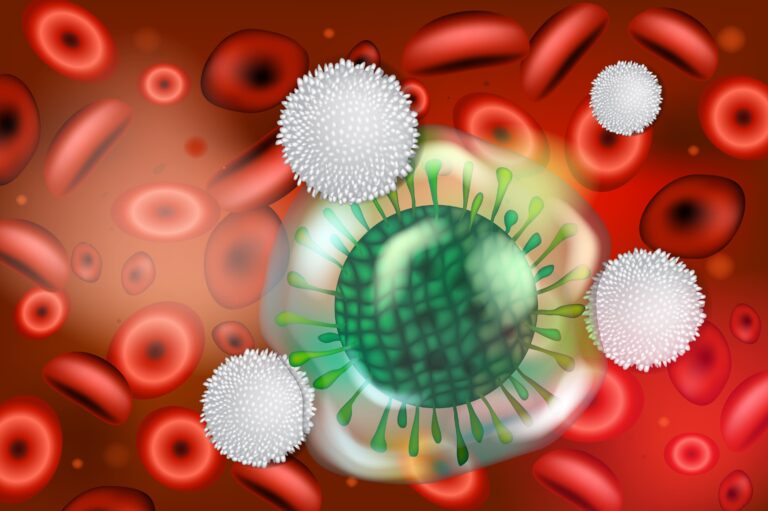The ELISA test (acronym of Enzyme Linked ImmunoSorbent Assay) is a test principally used In immunology to detect and/or assay a protein, antigen or antibody in a biological fluid sample . It has many practical applications; it is used to detect and quantify bacteriological or viral infections (such as HIV), to identify certain cancer markers, to determine the concentration of some legal or illegal drugs and even to confirm or infirm pregnancy.
Methods
There are four main existing ELISA tests; direct, indirect, sandwich and competitive.
Direct ELISA consists in asserting the presence of specific antibodies: in a sample are added the antigen and the fluid, if the antibodies of interest are present in the fluid, they react with the antigen.
The antigen has previously been modified (linked to an specific enzyme), then a substrate is added, this substrate reacts with the enzyme linked to the antigen, if the antigen binds to its antibody, the colour of the sample changes. If the sample becomes colourful, it means that the antibody of interest is present in the sample. The principal interest of this method is that it needs only a few manipulations to determine a result.
Indirect ELISA follows the same principle; in a sample are added the antigen and the fluid but there is a second step before evaluating the result. As previously, the antibodies (if present) react with the antigen , then second antibodies bind to the first antibodies. There are these second antibodies which have previously been marked with an enzymatic tracker that are detected . This test is more precise than direct ELISA and thereby, more used.
Sandwich ELISA is used to quantify specific antigen. In the sample are added capture antibodies, whose role is to bind only to the sought antigens. Then second tracker antibodies, whose role is to bind to the captured antigens are added, so that the antigens are sandwiched between two strata of antibodies. This test is for example used to detect HIV.
Competitive ELISA consists in quantifying a specific antigen by using the competitive binding principle. The sample is prepared with fixed antibodies and a mixture of quantified marked antigens and unmarked antigens whose quantity is to be determined. The two types of antigen enter into competition to bind to antibodies. The more antigen to quantify, the higher their proportion among fixed antigen, the lower the signal.
Reliability
Antibodies tests, or serological tests are not as efficient as molecular diagnostic tests to detect a disease at an early phase that is to say when patients haven’t yet an enough high level of antibodies to be detected, but they can confirm if a patient has been touched by the disease and if he has antibodies that could protect him against a future infection.
The detection technique is highly sensitive and so there are numerous false positive results (a result that is positive whereas the patient isn’t infected). On the other hand, ELISA tests can be not sensitive enough in the case of Lyme disease for example, a study concludes that ELISA test doesn’t detect seventy-five percent of infected patients.
Main uses
Pharmacology: ELISA is used to quantify various proteins, hormona and drug concentration.
Detection of diseases: Today ELISA is used to test for antibodies of SARS-COV-2 (COVID-19) ; if the antibodies are detected, it means that the patient has been touched by the disease.
ELISA test is the principal test used for AIDS diagnosis. It can detect infection marks around six weeks after the contamination. Among others, it is used to detect Lyme and dengue diseases. Recent tests are combined tests which are able to detect antibodies and antigens of a virus.
Pregnancy: In the case of suspected pregnancy, ELISA test is used to detect Human Chorionic Gonadotropin (HCG), in the urine of a woman. This hormone is produced only by an embryo so if it is detected, it means that the woman is pregnant.
Drugs: Forensic laboratories regularly use ELISA test to determine if a person did drugs and which quantity of it can be found in his organism.
Cancer: For example, in the case of cervical cancer, ELISA test is used to detect one of the key proteins of human papillomavirus (HPV).
Agribusiness
ELISA tests are currently used in agribusiness to check the products ; for example it shows its utility in the case of potatoe virus and onion or tomato bacteria presence, even tobacco and quinoa are tested. Since 1982, ELISA test has been used to help select sugar cane which are resistant to certain viruses.
The serological and bacterial detection use of the ELISA test has found a number of applications in the agribusiness domain ; by testing and selecting virus or bacteria resistant seeds and plants, it allows growers to produce healthier plants and so produce more. The application of use is wide : Agricultural crops, grasses, vegetables, flowers, shrubs, trees but also native and exotic species.
In the field of seeds transgenics (GMOs),identifications of genetic modifications as well as purity analyses are carried out. ELISA tests begin at level reproduction to confirm modifications or characteristics and continue during the production of seeds to confirm the degree of required purity of the characteristic. End users also use the tests ELISA for detecting GMOs in whole seeds, seeds processed and food products.
ELISA tests have found utility in a wide range of domains: medical monitoring, oncology, serology, bacteriology, pharmacology, forensic, pregnancy and even agri-food. The evolution of techniques and knowledge leads the ELISA test to become more efficient through years and to develop its uses to new fields of application, let’s guess what the next use will be.



